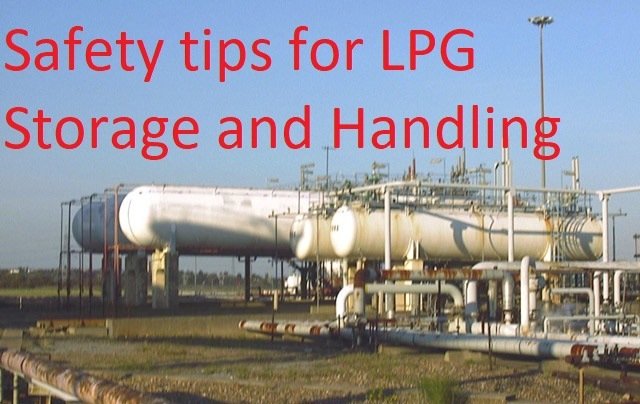Safe Handling and Storage of LPG: After Chlorine and Ammonia the third chemical of major industrial use is LPG (liquefied petroleum gas) As LPG, propane and butane are widely used as fuels. LNG, liquefied natural gas is mainly methane. It is stored as liquid and transmitted by high pressure pipeline for industrial and domestic uses. NGL, natural gas liquids are mainly ethane, propane and butane. They are also transmitted by pipeline. Fire and explosion are the main hazards associated with them. Boiling points and explosive limits of these hydrocarbons are as under:
Properties & Hazards of LNG:
| No. | Gas | BP degree C | LEL | UEL | |
| 1. | Propane | LNG & NGL | -42.1 | 2.3 | 9.5 |
| 2. | Butane | -0.5 | 1.9 | 8.5 | |
| 3. | Methane | LNG | -161.5 | 5.3 | 15 |
| 4. | Ethane | NGL | -88.6 | 3.0 | 12.5 |
| 5. | Ethylene | -103.9 | 2.7 | 36 | |
| 6. | Propylene | -47.7 | 2.0 | 11.1 | |
Commercial butane (n-butane) and propane are used as LPG. They exist as gases in ambient condition but can be liquefied under little pressure and on release of this pressure, they again become gases. As liquid its density is 0.5 and will float and vaporise on water surface. Therefore water is not good extinguishing media for LPG fire but it is essential to keep the vessel cool. Its vapour density is 1.5 and does not disperse easily. It tends to sink to the lowest possible level and if ignited in a confined space, it can explode also. Bottom ventilation (holes) near LPG cylinder allows leaking gas to go outside. Its explosive range is 2 to 10 %. Its flame can travel back to the source giving flash back. It can cause cold burns to the skin due to its rapid vaporisation and lowering of temperature. Its very high concentration in air, is anaesthetic and on dilution, it becomes asphyxiant. It gives order at 1/5th of its LEL (at 0.4% of gas in air). Heavy leaks give hissing sound or icing in the area of leak. Small leaks may be detected by soap solution (bubbling). Never use a naked flame to detect it.
Its empty tank may still contain LPG vapour and if air enters in empty tanks (due to any opening or leaking of valve) it can form an explosive mixture. Therefore it must be purged by inert gas first and gas-test should be made before doing any works on it.
Location & other Safety Aspect:
LPG tanks can be sited above or underground. In any case the manhole and the safety valves should remain in open well ventilated position. Guidelines of Explosive Act & Rules, SMPV Rules, Petroleum Act & Rules and Controller of Explosive must be followed.
LPG vessels should not be located one above the other. The ground underneath should be concreted or compacted and free from pits, drains and culverts. Weeds, grass, shrubs, trees or any combustible material should be removed from the ground. Separation distances are mentioned in table.
| Tank capacity in | Separation Distances in m | |||||
| Tonnes | Litres*1000 | Above Ground Vessels | Under Ground Vessels | |||
| From surrounding or source of ignition | With fire wall | Between vessels | From surrounding or source of ignition | Between vessels | ||
| 0.05 – 0.25 | 0.15 – 0.5 | 2.5 | 0.3 | 1 | 0.3 | 0.3 |
| 0.25 – 1.1 | 0.5 – 2.5 | 3 | 1.5 | 1 | 1 | 1.5 |
| 1.1 – 4 | 2.5 – 9 | 7.5 | 4 | 1 | 3 | 1.5 |
| 4 – 60 | 9 – 135 | 15 | 1.5 | 3 | 1.5 | |
| 60 – 150 | 135 – 337.5 | 22.5 | 0.25*sum of dia of 2 adjacent vessels | 3 | Depending on site condition | |
| >150 | >337.5 | 30 | 3 | |||
Slope should be given to the ground beneath the vessels, connections and equipment containing LPG to drive away any dripping or leakage towards a safe area. Such evaporation area or catchments pit should be at least 3 m from LPG vessels and have sufficient capacity to contain the largest credible leak and well ventilated to permit safe dispersion. Gas detectors should be provided in the pit to give warning of any LPG vapour.
For other details of fire walls, mechanical integrity, certification, marking, fitting (safety valves, drain connection, level gauges, valves, pumps and compressors), piping, vaporisers, security, fire precautions, loading and unloading facilities, commissioning and decommissioning, maintenance and examination, operational procedures and training.
Minimum safety distances are also given in IS:6044(part2) for LPG storage and installations Part 1 is for LPG cylinder installations.






It’s really a great and helpful piece of information. I am glad that you shared this useful info with us.